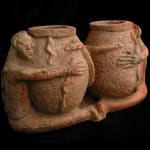Djenne Terracotta Double Anthropomorphic Jar, 1200 CE - 1600 CE
Terracotta
10.25 x 6
PF.4649 (LSO)
Further images
This outstanding figurative anthropomorphic double ceramic vessel was made by a ceramicist of the Djenne culture, centred in modern-day Mali. Insofar as can be ascertained, it is a unique example....
This outstanding figurative anthropomorphic double ceramic vessel was made by a ceramicist of the Djenne culture, centred in modern-day Mali. Insofar as can be ascertained, it is a unique example. It depicts two seated individuals facing one another, their feet touching. They are separated by a pair of vessels, which are as tall as they are (when seated). Their bodies are contiguous with the bodies of the pots, and they have their arms wrapped around them. The figure on the right even has his face “buried” in the side of the pot. The detailing of the pots differs – the one on the left is hatched, the other pockmarked. The figures are fairly detailed, and are thus intermediate between highly decorated, elongated Djenne representations and the more robustly expressionistic and roughly executed Bankoni specimens. Each vessel is decorated with snakes that are also crawling over the bodies of the human figures. The figures are naked save for bands around their waists and wrists.
The Djenne culture is focused upon the historic city of Djenne-Djenno in the Niger Inland Delta of modern Mali. It is notable for being the oldest city in Sub-Saharan Africa, and the onetime hub of an enormous trading empire that dominated this area of Africa in the Middle Ages. It was founded by the Bozo (allied with the Bamana) people in about 800 AD, and was relocated upstream to take advantage of Trans-Saharan trade networks. The Djenne style is technically part of the Malian Empire – along with numerous other groups (i.e. the Tenenku, Bura and Bankoni [centred on the town of Bamako]) – but the city itself never was. Indeed, the Malian Empire is said to have tried to conquer the city-state 99 times before giving up. Djenne-Djenno remained unassailed until the 1470s, and never ceased in terms of influence despite changing hands several more times. It only waned in importance when the French arrived at the end of the 19th century.
Djenne culture – and that of the closely allied Bankoni group – is highly significant in the development of West African art styles. Their figures are invariably highly expressionistic, with little regard for proportion and scale, but with phenomenal modelling skill. Owing to the popularity of Djenne pieces, sites have been systematically plundered so we know almost nothing of their culture beyond its evident refinement. Pieces such as this are doubly mysterious as we can have no idea what the piece was used for, and we are also unsure as to the significance of the juxtaposition of humans, pots and snakes. The size of the pot and its extensive ornateness obviates it against being a purely secular item, and it is likely to have held something of ritual or perhaps financial importance. The humans may represent slaves, servants, or just decorative elements. The Djenne are known to have used snakes as decorative elements on their pots, either as curvilinear borders, or to frame – or even devour – a human figure on the vessel’s surface. Whatever its significance, however, this is a rare and impressive piece of ancient African art.
The Djenne culture is focused upon the historic city of Djenne-Djenno in the Niger Inland Delta of modern Mali. It is notable for being the oldest city in Sub-Saharan Africa, and the onetime hub of an enormous trading empire that dominated this area of Africa in the Middle Ages. It was founded by the Bozo (allied with the Bamana) people in about 800 AD, and was relocated upstream to take advantage of Trans-Saharan trade networks. The Djenne style is technically part of the Malian Empire – along with numerous other groups (i.e. the Tenenku, Bura and Bankoni [centred on the town of Bamako]) – but the city itself never was. Indeed, the Malian Empire is said to have tried to conquer the city-state 99 times before giving up. Djenne-Djenno remained unassailed until the 1470s, and never ceased in terms of influence despite changing hands several more times. It only waned in importance when the French arrived at the end of the 19th century.
Djenne culture – and that of the closely allied Bankoni group – is highly significant in the development of West African art styles. Their figures are invariably highly expressionistic, with little regard for proportion and scale, but with phenomenal modelling skill. Owing to the popularity of Djenne pieces, sites have been systematically plundered so we know almost nothing of their culture beyond its evident refinement. Pieces such as this are doubly mysterious as we can have no idea what the piece was used for, and we are also unsure as to the significance of the juxtaposition of humans, pots and snakes. The size of the pot and its extensive ornateness obviates it against being a purely secular item, and it is likely to have held something of ritual or perhaps financial importance. The humans may represent slaves, servants, or just decorative elements. The Djenne are known to have used snakes as decorative elements on their pots, either as curvilinear borders, or to frame – or even devour – a human figure on the vessel’s surface. Whatever its significance, however, this is a rare and impressive piece of ancient African art.









